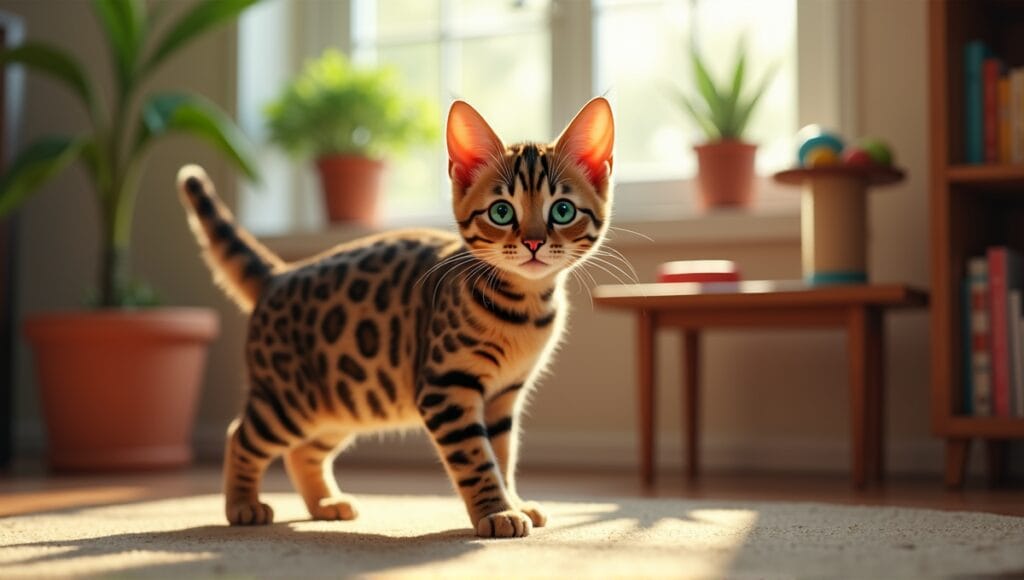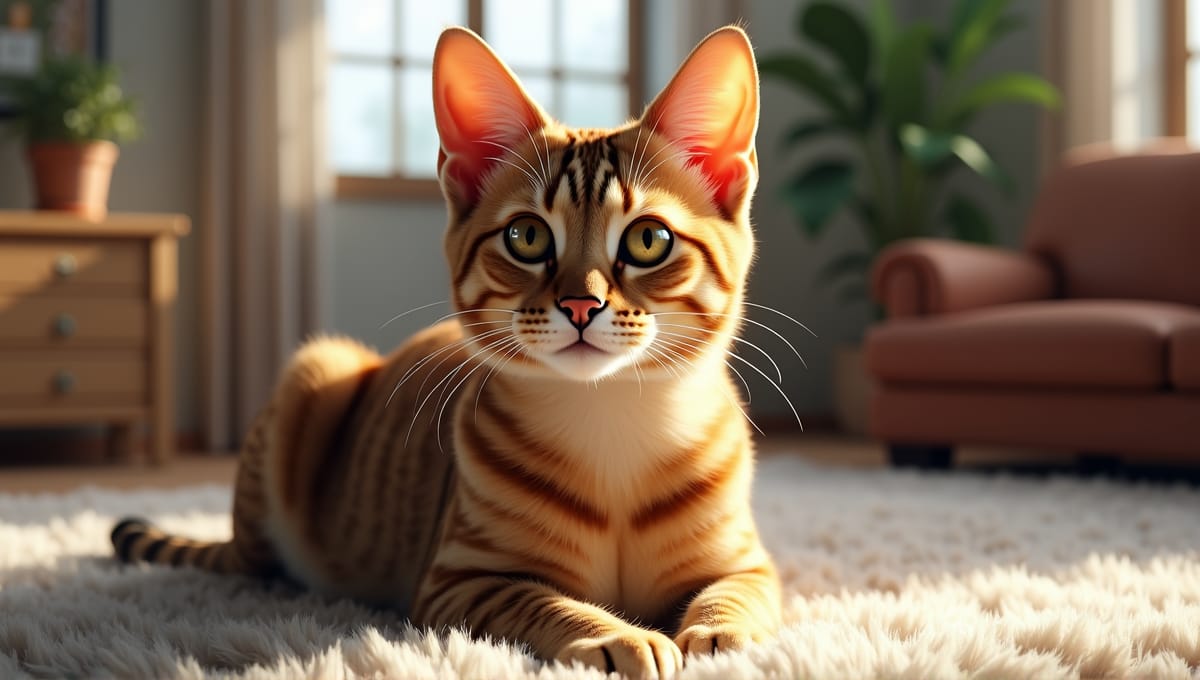Bengal cats are beautiful, wild-looking cats that appeal to many people. In my years of experience as a cat lover, I’ve observed how these exotic beauties capture the hearts of prospective cat parents. However, before you get seduced by their leopard-like appearance, it’s important to understand whether a Bengal cat is really the best fit for your home. So, let’s discuss what makes this breed unique.
Bengal Cat Breed Overview

Bengal cats are an interesting breed with a wild appearance and domestic disposition. They were created in the 1960s by breeding Asian leopard cats with domestic cats. The objective was to produce a cat that looked like a leopard but behaved like a regular house cat.
These cats are medium to large in size with a muscular build and a coat that feels like silk. Their most defining characteristic is their spotted or marbled coat, which strongly resembles that of a leopard.
As for their temperament, Bengal cats are active and playful. They’re also incredibly smart and inquisitive, so they love to explore. You’ll often find them climbing, perching, or playing with interactive toys. Bengal cats are also relatively talkative and will happily “talk” to you throughout the day.
Understanding Bengal cat generations is important. F1 through F4 essentially tells you how many generations removed the cat is from its wild ancestor. An F1 Bengal, for example, is 50% Asian leopard cat, and these cats can be very difficult to care for. On the other hand, an F4 or higher is considered 100% domestic, making them the most suitable option for the average person to keep at home.
Unique Coat Designs and Hues of Exotic Felines
Bengal cats are most famous for their stunning and unique coat patterns. There are two primary patterns: spotted and marbled. Spotted patterns will have spots or rosettes, and marbled patterns will have a flowing, marbled pattern.
The most common Bengal cat colors are brown, silver, and snow. Brown Bengals have black or dark brown markings on a golden or light brown background. Silver Bengals have black or dark grey markings on a silver or white background. Snow Bengals can range in color from white to cream with contrasting dark markings.
Many Bengal cats have something known as the “glitter gene,” which gives the coat a sparkling appearance. This gene causes the individual hairs to have a hollow core that reflects light, producing a glittery effect.
There are also some other rare color variations in Bengal cats, including blue, charcoal, and melanistic (which is a completely black Bengal). These colors are less common and often highly desired by breed enthusiasts. If you’re interested in other exotic cat breeds, there are many fascinating options to explore.
Bengal Cat Care Requirements
Bengal cats have some specific care requirements to ensure they stay healthy and happy. They have high protein requirements to fuel their active lifestyle. To meet these needs, create a diet of high-quality dry and wet food designed specifically for active breeds.
Grooming Bengal cats is a breeze thanks to their short coats. You’ll generally only need to brush them once per week to remove loose hair and distribute oils across their skin. They don’t need regular baths unless they roll in something particularly dirty.
Exercise is paramount for Bengal cats, and they’ll need a lot of playtime and activities to burn off energy. Here are some ideas:
- Interactive toys like feather wands or laser pointers
- Climbing structures and cat trees
- Puzzle feeders to keep them mentally sharp
- Leash training so they can explore the outdoors under close supervision
You’ll also want to focus on environmental enrichment, so consider the following:
- Perches by windows so they can bird watch
- A cat-safe outdoor enclosure or catio
- Regularly rotating toys
- Hiding spots or tunnels for play
Because these cats are so active, they’ll need both mental and physical stimulation to prevent boredom or destructive behaviors.
Medical Concerns for This Exotic Breed

Bengal cats are generally healthy, although they, like all breeds, are susceptible to certain health issues. Common concerns include:
- Hypertrophic cardiomyopathy (heart disease)
- Progressive retinal atrophy (eye disease)
- Hip dysplasia
- Patellar luxation (kneecap dislocation)
Some genetic health concerns in Bengals include PK deficiency (a blood disorder) and Bengal progressive retinal atrophy. Responsible breeders will test for these conditions.
Regular veterinary check-ups are essential for preventative care. I recommend annual exams and keeping up with vaccinations and parasite prevention.
Bengal cats have an average lifespan of 12-16 years. Like all cats, they may develop age-related issues as they get older. Regular check-ups can help catch and manage these conditions early. However, many breeders will argue that early age-related issues (like arthritis) are less common in Bengals given their active nature.
| Health Issue | Bengal Cats | Average for All Cat Breeds |
|---|---|---|
| HCM | Higher risk | Moderate risk |
| PRA | Higher risk | Lower risk |
| Hip Dysplasia | Moderate risk | Lower risk |
| Longevity | Average | Average |
Bengal Cat Behavior and Training
Bengals are among the most intelligent and trainable of all cats. They are fast learners that enjoy mental stimulation. Additionally, Bengals often exhibit dog-like behaviors, such as playing fetch and walking on a leash.
Common Bengal cat behaviors include:
- High energy
- Excellent climbing abilities
- The peculiar obsession with water
- Chatty personality
Socialization is essential for Bengal cats, so introduce them to many different people, environments, and other pets while they are young. This will help prevent any fear or aggression issues as they get older.
Below are some positive reinforcement training tips:
- Use your cat’s favorite toy or treats as a reward.
- Keep training sessions short and entertaining.
- Remain consistent with your commands and rewards.
- Never use punishment. Instead, redirect your cat’s behavior.
- Start with basic commands, such as come or sit.
And, as with any cat, especially an energetic Bengal, training requires patience.
Living with a Bengal Cat
Bengal cats require plenty of space to run, jump, and play. A larger home with vertical space (e.g., cat trees or wall-mounted shelves) is best. You’ll also have to “Bengal-proof” your house as they will discover everything.
With proper socialization, they’re good with children and other pets. Their active nature also makes them good pets for active families. However, monitor play with young children, as Bengals tend to play rough.
Bengals are notorious for being talkative. They will chat with you all day, using a wide range of chirps, trills, and meows. If you don’t want a chatty cat, the Bengal isn’t the breed for you.
Bengals are very high energy. They require several play sessions and lots of toys each day to keep them busy. If a Bengal becomes bored, it will find something to destroy.
Bengals aren’t well-suited for apartment living. They need space to run and climb, so if you live in an apartment, be prepared to provide plenty of vertical space and lots of toys.
Buying an Exotic Spotted Feline

Bengal cats tend to be more expensive than other breeds, with prices ranging from $1,500 to $3,000 or more depending on generation color, and pattern. Show-quality Bengals are even more expensive.
When searching for a Bengal, select a reputable breeder that prioritizes the health and temperament of their cats. Steer clear of pet stores or backyard breeders. You can also adopt a Bengal, as there are rescues specifically for this breed.
Before you purchase a Bengal from a breeder, ask about:
- Health certifications for genetic diseases
- Seeing the kitten’s parents
- Their socialization process
- If they offer a health guarantee
Ask the breeder to provide all of the necessary documentation, including:
- Pedigree papers
- Health certificates
- Vaccination records
- A spay or neuter contract for pet quality kittens
What are the essentials for a Bengal cat owner? You’ll need high-quality cat food, a few sturdy scratching posts, interactive toys, a large litter box, a cat tree, and a water fountain (many Bengals love running water).
Ensure that your home is ready by securing any loose items, removing toxic plants, and setting up a room where your Bengal cat can be comfortable while acclimating to its new environment.
Bengal cats weigh between eight and 15 pounds, with males being larger than females. With proper care you can expect your Bengal to live between 12 and 16 years. If you provide the right home, these are active cats that can provide many years of fun and companionship.
If you’re considering other Chinese cat breeds, you might be interested in the Li Hua cat, which is another fascinating breed with a rich history.
Parting Thoughts
Bengals are interesting, high maintenance cats. They require plenty of attention, play, and mental stimulation. In return, you’ll have a loyal, affectionate Bengal. Just ensure you can meet their high energy and intelligence needs before purchasing a Bengal. Bengals are loyal, affectionate cats when cared for properly. So again, the key to a happy life with a Bengal is responsible ownership.






